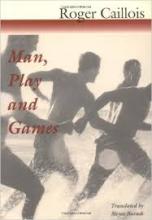
Man, Play and Games is a classic study of play and games and how they affect society and become a part of daily life. The book was written by Roger Caillois and was originally published in 1958 as Les jeux et les hommes. The English translation by Meyer Barash was published in 1961.
The book characterizes the nature of play, distinguishes between games with rules and free play, and gives a description of four different types of play – competition, chance, simulation, and vertigo. The major portion of the book looks at sociological ties to play and games from primitive cultures as well as the ancient historic cultures of West and East and how they evolved over time.
The author notes the work of Johan Huizinga in his book Homo Ludens and his description of play. However, he expands on Huizinga’s views and defines play as “an activity which is essentially:
- Free: in which playing is not obligatory; it if were, it would at once lose its attractive and joyous quality as diversion;
- Separate: circumscribed within limits of space and time, defined and fixed in advance;
- Uncertain: the course of which cannot be determined, nor the result attained beforehand, and some latitude for innovations being left to the player’s initiative;
- Unproductive: creating neither goods, nor wealth, nor new elements of any kind; and, except for the exchange of property among the players, ending in a situation identical to that prevailing at the beginning of the game;
- Governed by rules: under conventions that suspend ordinary laws, and for the moment establish new legislation, which alone counts;
- Make-believe: accompanied by a special awareness of a second reality or of a free unreality, as against real life.”1
Caillois proposes four fundamental categories of play to use to describe the complexities of games by their roles: agôn (competition), alea (chance), mimicry (simulation), and ilinx (vertigo). These are further classified as paidia, a more playful form of activity, and ludus, a play that is structured with rules.
Because of the competitive nature of the games in this category, agôn implies that sustained attention, appropriate training, diligent application, and the desire to win is required. While competitive, the games may not need to be regulated (paidia), such as in racing and rough and tumble play. Games with rules (ludus) particularly fit this category, such as chess, boxing, football, and contests and sports in general.
Games of chance (alea) result in an outcome over which the players have no control and must be taken as fate rather than mastery. The player is entirely passive and awaits his destiny, such as in the outcome of a roll of the dice. Flipping a coin or saying a counting rhyme have little to do with rules, but betting games, roulette, and lotteries are played in strict parameters.
When engaging in make-believe or making others believe he is someone other than himself, mimicry comes into play. Suspension of reality and illusion are the basis of this play form. The use of masks and disguises, games of illusion, and children’s pretend play are freely played with no rules attached, but theater, puppet shows, and performances in general do have restrictions and a framework that control the event.
The last kind of game, ilinx, includes those based on the pursuit of vertigo, an attempt to momentarily destroy the stability of perception and inflict a kind of panic on an otherwise lucid mind. Activities include spinning, swinging, racing downhill, and sledding that are enjoyed just for fun. More structured activities for experiencing vertigo include amusement park rides, tightrope walking, skiing, and mountain climbing.
Caillois further explains his categories of play to show how they become ingrained in culture, institutionalized in everyday life, and when taken to an extreme, corrupted. Enjoyment of sports is a popular form of competition, but in the day to day realm, people are faced with competitive examinations and economic competition. The corruption of competition can lead to trickery, violence, and seeking power. Regular games of chance, such as lotteries and casinos, are a cultural form of play; speculation on the stock market is an institutional form of play; and chance is corrupted when taken to the extreme of superstitions and astrology. Culturally, theater, movies, and hero-worship involve simulation, while uniforms and ceremonial etiquette move to the institutional realm. The corruption of simulation can result in alienation or a split personality. The highs of experiencing vertigo can be attained with fun activities, such as mountain climbing, skiing, and speed, and can be further enjoyed by entering professions requiring control of vertigo. Taken to the extreme, craving the feeling of vertigo can lead to alcoholism and drug abuse.
The author further shows how his categories of play can be paired: competition with chance; competition with simulation; competition with vertigo; chance with simulation; chance with vertigo; and simulation with vertigo. In games with competition and chance, both are governed by rules; games with simulation and vertigo demonstrate a free act of will stemming from the satisfaction felt in overcoming an arbitrarily conceived and voluntarily accepted obstacle.
Caillois devotes the major portion of his study to describing the importance and evolution of games in various cultures. He goes on to explore the sociological implications of these games on the societies in which they have been played.
- 1. Caillois, Roger. Man, Play and Games. Champaign, IL: University of Illinois Press. Reprint. 2001. pp. 9-10.

